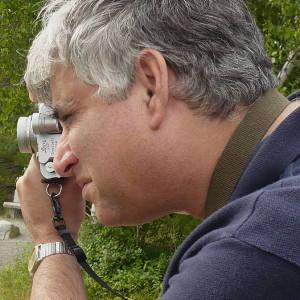Bookends.
The two cameras in today's Blip represent, not quite the first and last steps in the evolution of miniature photography, but pretty close to it. The little Leica Model IIIa was introduced in 1935, ten years after Oscar Barnack's miniature marvel, the Leitz Camera (or, as the company called it, the Leica) was introduced to the world at the Leipzig Expo. The Model IIIa was offered in the Leitz catalog until 1946 and was the first of the Barnack cameras to have the 1/1000-second shutter speed. Perhaps it’s no coincidence that this refinement was introduced just in time for the 1936 Berlin Olympics, to enable photographers to freeze the motion of the world’s fastest athletes.
I acquired this 1936 camera in 2004 from a dealer for the same money I paid for the Lumix GX1 also pictured in the Blip. When I opened the package I couldn’t believe that a 68-year-old camera could be in such pristine condition. Being curious to know its provenance, I dropped an email off to the Leitz folks in Wetzlar. Eventually a response came indicating that this very camera (according to the serial number) had been bought from a dealership in Frankfurt on June 10, 1936. The factory records probably also showed the name of the customer, but this information was not shared with me. What stories could this camera tell if it could speak? My IIIa has been a constant travel companion until I bought the GX1 last year. Even a confirmed Luddite like me has realized the convenience and exposure latitude which digital photography offers over film, so I researched the best and most cost-effective way to be able to use all my Leica lenses on a reasonably-priced digital camera body. The Leica M9 did not fit… It's true that it has a 1:1 sensor; no crop factor, so higher effective resolution, and, of course, it's a Leica, so it's a work of art. But $7,000 for a body only? Really?????? But I thought that since Leica and Panasonic are partners in the production of consumer cameras, why not look there first? Panasonic was just about to announce the replacement for the GX1, the GX7, with further refinements, bigger body and a much bigger price tag. I decided to go with the GX1; it has not disappointed. The most remarkable part of it all for me is that it is possible to mount a lens made in 1937 on a camera made in 2011 merely by using a couple of adapters. But I miss using the IIIa and my other film Leicas the way I used to. They're very special old friends, family members really, because two of them were inherited from my late father. Now they get used for vacations with the car when the weight doesn't matter and the whole day stretches before me to think about photography. There will be more on this topic.

Comments
Sign in or get an account to comment.


